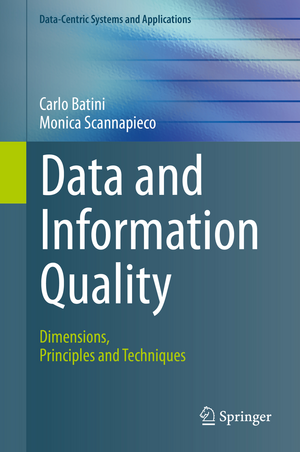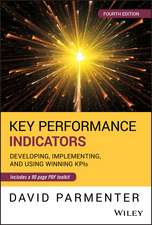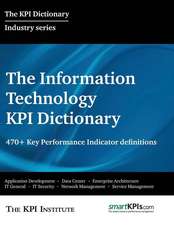Data and Information Quality: Dimensions, Principles and Techniques: Data-Centric Systems and Applications
Autor Carlo Batini, Monica Scannapiecoen Limba Engleză Hardback – 13 iun 2016
To this end, it presents an extensive description of the techniques that constitute the core of data and information quality research, including record linkage (also called object identification), data integration, error localization and correction, and examines the related techniques in a comprehensive and original methodological framework. Quality dimension definitions and adopted models are also analyzed in detail, and differences between the proposed solutions are highlighted and discussed. Furthermore, while systematically describing data and information quality as an autonomous research area, paradigms and influences deriving from other areas, such as probability theory, statistical data analysis, data mining, knowledge representation, and machine learning are also included. Last not least, the book also highlights very practical solutions, such as methodologies, benchmarks for the most effective techniques, case studies, and examples.
The book has been written primarily for researchers in the fields of databases and information management or in natural sciences who are interested in investigating properties of data and information that have an impact on the quality of experiments, processes and on real life. The material presented is also sufficiently self-contained for masters or PhD-level courses, and it covers all the fundamentals and topics without the need for other textbooks. Data and information system administrators and practitioners, who deal with systems exposed to data-quality issues and as a result need a systematization of the field and practical methods in the area, will also benefit from thecombination of concrete practical approaches with sound theoretical formalisms.
| Toate formatele și edițiile | Preț | Express |
|---|---|---|
| Paperback (1) | 827.78 lei 6-8 săpt. | |
| Springer International Publishing – 26 mai 2018 | 827.78 lei 6-8 săpt. | |
| Hardback (1) | 834.36 lei 6-8 săpt. | |
| Springer International Publishing – 13 iun 2016 | 834.36 lei 6-8 săpt. |
Din seria Data-Centric Systems and Applications
- 20%
 Preț: 777.06 lei
Preț: 777.06 lei - 20%
 Preț: 340.94 lei
Preț: 340.94 lei - 20%
 Preț: 337.91 lei
Preț: 337.91 lei - 20%
 Preț: 499.23 lei
Preț: 499.23 lei - 20%
 Preț: 1062.89 lei
Preț: 1062.89 lei - 20%
 Preț: 344.76 lei
Preț: 344.76 lei - 20%
 Preț: 663.61 lei
Preț: 663.61 lei - 20%
 Preț: 607.51 lei
Preț: 607.51 lei - 20%
 Preț: 347.74 lei
Preț: 347.74 lei - 20%
 Preț: 512.72 lei
Preț: 512.72 lei - 20%
 Preț: 339.14 lei
Preț: 339.14 lei - 20%
 Preț: 698.57 lei
Preț: 698.57 lei - 20%
 Preț: 650.27 lei
Preț: 650.27 lei - 20%
 Preț: 375.69 lei
Preț: 375.69 lei - 20%
 Preț: 420.84 lei
Preț: 420.84 lei - 20%
 Preț: 479.30 lei
Preț: 479.30 lei - 20%
 Preț: 321.70 lei
Preț: 321.70 lei - 20%
 Preț: 726.16 lei
Preț: 726.16 lei - 20%
 Preț: 513.05 lei
Preț: 513.05 lei - 20%
 Preț: 333.50 lei
Preț: 333.50 lei - 20%
 Preț: 333.88 lei
Preț: 333.88 lei - 20%
 Preț: 520.82 lei
Preț: 520.82 lei
Preț: 834.36 lei
Preț vechi: 1042.95 lei
-20% Nou
159.67€ • 165.69$ • 133.46£
Carte tipărită la comandă
Livrare economică 15-29 martie
Specificații
ISBN-10: 3319241044
Pagini: 500
Ilustrații: XXVIII, 500 p. 260 illus., 53 illus. in color.
Dimensiuni: 155 x 235 x 29 mm
Greutate: 0.92 kg
Ediția:1st ed. 2016
Editura: Springer International Publishing
Colecția Springer
Seria Data-Centric Systems and Applications
Locul publicării:Cham, Switzerland
Cuprins
Recenzii
Notă biografică
Monica Scannapieco is a researcher at Istat, the Italian National Institute of Statistics since 2006. She earned a University Degree in Computer Engineering with honors and a Ph.D. in Computer Engineering at Sapienza - Università di Roma. She is the author of more than 100 papers mainly on data quality, privacy preservation and data integration, published in leading conferences and journals in databases and information systems. She has been involved inseveral European research projects on data quality and data integration.
Textul de pe ultima copertă
To this end, it presents an extensive description of the techniques that constitute the core of data and information quality research, including record linkage (also called object identification), data integration, error localization and correction, and examines the related techniques in a comprehensive and original methodological framework. Quality dimension definitions and adopted models are also analyzed in detail, and differences between the proposed solutions are highlighted and discussed. Furthermore, while systematically describing data and information quality as an autonomous research area, paradigms and influences deriving from other areas, such as probability theory, statistical data analysis, data mining, knowledge representation, and machine learning are also included. Last not least, the book also highlights very practical solutions, such as methodologies, benchmarks for the most effective techniques, case studies, and examples.
The book has been written primarily for researchers in the fields of databases and information management or in natural sciences who are inte
rested in investigating properties ofdata and information that have an impact on the quality of experiments, processes and on real life. The material presented is also sufficiently self-contained for masters or PhD-level courses, and it covers all the fundamentals and topics without the need for other textbooks. Data and information system administrators and practitioners, who deal with systems exposed to data-quality issues and as a result need a systematization of the field and practical methods in the area, will also benefit from thecombination of concrete practical approaches with sound theoretical formalisms.
Caracteristici
Descriere
This book provides a systematic and comparative description of the vast number of research issues related to the quality of data and information. It does so by delivering a sound, integrated and comprehensive overview of the state of the art and future development of data and information quality in databases and information systems.
To this end, it presents an extensive description of the techniques that constitute the core of data and information quality research, including record linkage (also called object identification), data integration, error localization and correction, and examines the related techniques in a comprehensive and original methodological framework. Quality dimension definitions and adopted models are also analyzed in detail, and differences between the proposed solutions are highlighted and discussed. Furthermore, while systematically describing data and information quality as an autonomous research area, paradigms and influences deriving from other areas, such as probability theory, statistical data analysis, data mining, knowledge representation, and machine learning are also included. Last not least, the book also highlights very practical solutions, such as methodologies, benchmarks for the most effective techniques, case studies, and examples.
The book has been written primarily for researchers in the fields of databases and information management or in natural sciences who are interested in investigating properties of data and information that have an impact on the quality of experiments, processes and on real life. The material presented is also sufficiently self-contained for masters or PhD-level courses, and it covers all the fundamentals and topics without the need for other textbooks. Data and information system administrators and practitioners, who deal with systems exposed to data-quality issues and as a result need a systematization of the field and practical methods in the area, will also benefit from the combination of concrete practical approaches with sound theoretical formalisms.






















